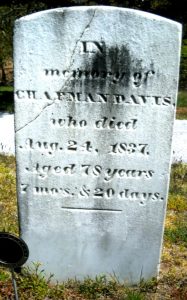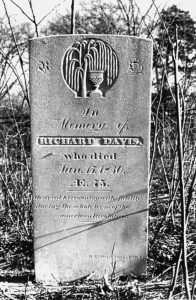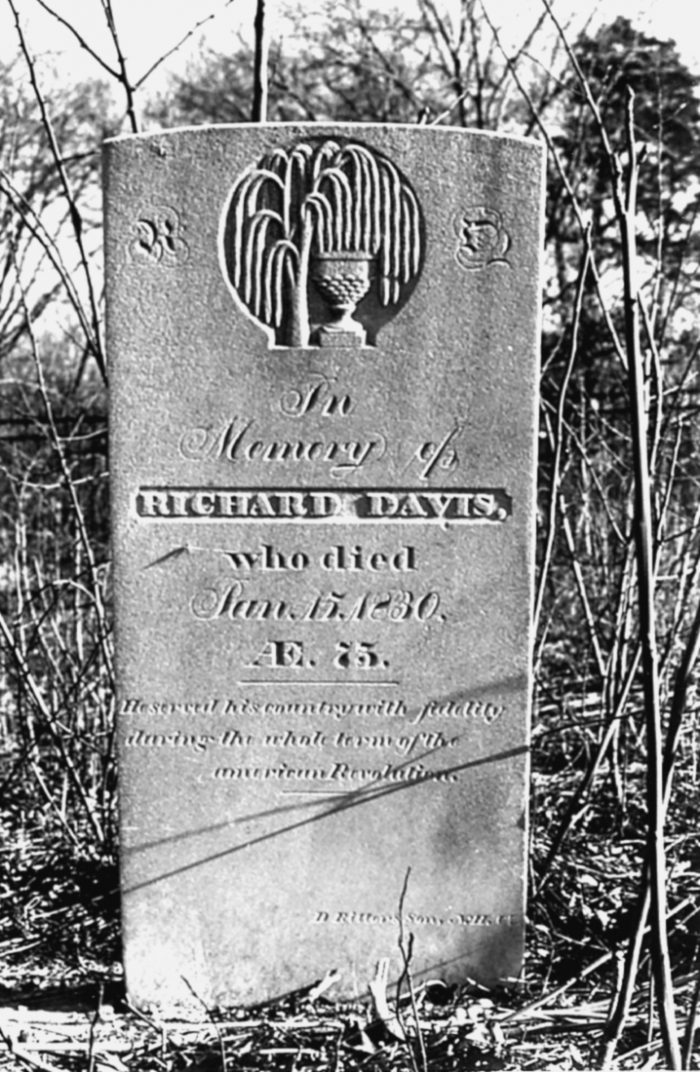By Edna Davis
Old Mans (Mount Sinai) was a small hamlet of 16 families in 1775, but seven young men volunteered for service during the Revolutionary War.
Two sets of brothers were among this group. All of them traveled to parts of the country they never would have done if not for the army, including northern and western New York, Canada, Pennsylvania, and finally Yorktown, Virginia. Often armies walked for miles before a battle, food was always short, clothing did not meet the needs of the weather, and illness was always present. By the end of the war most of the men were worn out.
New York including Long Island was finally evacuated by the British Nov. 25, 1783. All New York units were disbanded Nov. 15, 1783 at Newburgh, New York. The men had to find their own way home, and once home, there was little time to rest and recuperate from the war as they had to support themselves and their families.
All seven of the men survived the war, but not all of them moved back to Old Mans. Each of them did return to work, most were laborers, but one was a tailor, one a boatman, and one a farmer. They could work as they expected, but as they grew older, they were finding the effects of deprivations during the war started to affect their abilities. But they had to continue as there was no other income for their families. This changed in 1818.
Congress was divided on the issue of providing pensions for the veterans. It was a contentious debate for 30 years, but by 1818 the pension act was passed. Veterans could apply for pension relief, as could their widows and the disabled. The major portion of the application was a deposition from the veteran or his widow given in front of a Justice of the Peace, written by a clerk.
Other individuals could provide supporting evidence of service. Oral histories were required as few records survived or were not available to the individuals. Few of the men could find any paperwork including their discharge papers. The deposition had to include dates of service, which unit or units, officers, battles, discharge. Recall of this amount of information, especially after 30 years, proved to be difficult for some men more so than for others.
To qualify man had to have served at least nine months, must be “in reduced circumstances” and “in need of assistance from their government.” All seven men proved they qualified for a pension.
Richard Davis, age 18, was the first to sign up in May of 1775. He was assigned to the 2nd Regiment of the New York Line of the Continental Army. When his term of enlistment was up, he reenlisted for the duration of the war. He achieved the rank of sergeant.
At the Battle of Saratoga in 1777, he received a scalp wound from a musket ball, but he was able to continue to fight and was at the surrender of British General John Burgoyne and his entire army. He participated in many of the major and minor battles with the final battle at Yorktown where General Charles Cornwallis surrendered.
Richard was discharged on June 6, 1783. He settled in New York City where he worked as a boatman. By 1790 he had moved back to Old Mans where he married and raised his family and continued as boatman. In 1818 he applied for a pension due to his “bodily infirmities being afflicted with rheumatism and was frequently incapable of attending to his business.” Upon his death his wife, Temperance, applied for a widow’s pension which she received based on the information she knew of her husband’s war time activities. They are buried in the Phillips-Davis Cemetery on North Country Road, Mount Sinai.
Jeremiah Kinner, age 18, enlisted for one year in the militia company of Captain Selah B. Strong in February 1776. His first assignment was to a lookout post at Mt. Misery (Belle Terre) to watch for possible invasion of the British and Tories by way of Long Island Sound.
In August 1776 he was pulled with his company to the west end of Long Island as a part of the regiment commanded by Colonel Josiah Smith, Brigade of General Nathaniel Woodhull. Their assignment was to collect all the cattle and drive them east out of the reach of the British. This activity was thwarted by the British and resulted in the capture of General Woodhull.
Jeremiah with many of the other militia men were able to reach the patriot lines in Brooklyn and were evacuated to Manhattan where they fought with the rest of the army while retreating north up Manhattan to the Bronx and Westchester.
When his year enlistment was up, he was discharged by Lieutenant Caleb Brewster and returned home to Old Mans. He remained home “until the British took possession of that part of Long Island.”
He left the island moving to Goshen, Orange County, New York. Once he settled in, he joined the local militia under Captain McDowell of Colonel Tuston’s regiment. At the Battle of the Minisink he was wounded in the knee and was next to Colonel Tuston when the colonel was killed. Jeremiah was sent back to Goshen to recover from his wound which took six months. For the rest of the war the militia unit joined the Continental Army in battles in western New York.
At the end of the war he returned to Old Mans where he married and raised his family. He was a laborer and did not apply for a pension until 1833 when he was 74.
Nathan Phillips, age 22, enlisted for one year in the 4th Regiment of the New York Line Captain Daniel Roe’s company in March of 1776. He served as the company fifer. When he was discharged in March of 1777, he returned home where he spent the rest of his life. He married and raised his family. He was a laborer by trade. He applied for a pension “owing to my bodily infirmities being afflicted with rheumatism and in indigent circumstances.”

Chapman Davis, age 17, younger brother of Richard, enlisted in the spring of 1776 and assigned to the 2nd Regiment of the New York Line of the Continental Army. He participated in the Battle of Saratoga and the surrender of General John Burgoyne. He fought throughout the war and was at the final battle at Yorktown and the surrender of General Charles Cornwallis. After the war he married and moved to a farm in Aquebogue. He applied for a pension and received it in 1819 but was required to reapply in 1820. By that time, he was a widower with four children the oldest being 20 years old. He was suffering from ill health and having difficulty working his farm. His farm was 250 acres worth $2,788, but his mortgage was $2,800.
He gave his deposition before David Warner one of the judges in the Court of Common Pleas, however by 1820 the paperwork was a printed form which had to be purchased. The Judge requested the Pension Board to accept the handwritten application as “Mr. Davis is a very poor man and not able to be at the expense of making out a new declaration.”
Joshua Davis, age 19, joined the 4th New York Line as a private in April 1776 where he served until 1778 when General Washington had him, he transferred to the Whaleboat service under Captain Caleb Brewster. Brewster chose the men he wanted in his unit and “he would choose Long Island men as they knew the harbors and waterways of Long Island.” Joshua grew up on the family farm adjacent to Old Mans harbor. It is also probable that he and Brewster knew each other as Brewster grew up in Setauket.
Caleb Brewster is known for his activities as a member of the Culper Spy Ring, but that was not all he did. He made frequent forays to Long Island to collect intelligence of British activity on Long Island. One such foray had him observing the Maryland Loyalist Militia which was bivouacked in Miller’s Place 1778. He also fought British and Loyalist ships that were sailing on the sound.

During Benjamin Tallmadge’s raid on the Fort at the Manor of St. George, Joshua Davis was one of the men guarding the boats in the Old Mans Harbor. His discharge papers included a Badge of Merit for his faithful service.
After the War Joshua became a tailor, married, and raised his family in Greenfield, Fairfield, Connecticut. As he grew older his eyesight started to fail him and his general infirmity caused him to find employment for more than one day a week. He also had lameness in his left leg and back making it impossible to rise from his bed. He is buried with his family in Greenfield, Fairfield, Connecticut.
George Norton, age 22, grew up on Shore Road. He enlisted in the 4th Regiment of the New York Line of the Continental Army in the spring of 1776. He entered as a private, but eventually was promoted to sergeant and served for seven years. Upon discharge he also received the “Badge of Merit for seven years of faithful service.”
After the War he returned to Old Mans, married, and raised a family. By 1818, he is in indigent circumstances. In 1820 he was brought into court and upon examination by the judges he is declared insane and incapable of taking an oath. His wife, Elizabeth, appeared in the court stating he is generally insane and incapable of attending to his business. She had been taking care of everything. Two of their sons, wives, and children, and their own 14-year-old son lived in the house. His support comes mainly from the several properties he owned.
Jonathan Kinner, age 18, younger brother of Jeremiah, enlisted in the Continental Army being assigned to the 4th Regiment of the New York Line in 1777. In 1778 General Washington ordered Jonathan transferred to the Whaleboat service, Captain Caleb Brewster where he served for the rest of the war. Again, he was chosen because he was “a Long Island man.”
When he was a child his family moved from Brooklyn to a farm on Old Mans Harbor adjacent to the farm of Joshua Davis’ family. When he was discharged, he also was awarded the “Badge of Merit for length of service.” He remained in Connecticut, married, and raised his family in Weston. He applied for and received a pension in 1819 but was required to reapply in 1820 giving a detailed inventory of his property and household goods. He is buried in Connecticut with his family.
The Revolutionary War brought about freedom from Britain, but the long years of fighting took its toll on many of the men and their families.
Edna Davis Giffen is the Recording Secretary of the Miller Place-Mt. Sinai Historical Society. She enjoys doing history research of Mt. Sinai and Miller Place, and helping others learn about their community.





